CIV ENG 3P04 Assignment 1: Concrete Workability and Aggregate Analysis
VerifiedAdded on 2022/10/11
|8
|1585
|7
Homework Assignment
AI Summary
This assignment solution addresses key concepts in civil engineering materials and design, focusing on cement and concrete. It begins with a detailed explanation of the cement manufacturing process, from raw material extraction to shipping, including the role of additives like gypsum and the use of high sulphate resistant cement. The solution then defines and explains crucial concrete properties, such as workability and fineness modulus, and discusses different cement types, like High Early Strength Portland Cement, and aggregate grading. The document also covers sulphate attack and the significance of aggregate moisture states (oven dry, air dry, saturated surface dry, and wet) and their impact on concrete strength. The solution includes procedures for determining natural and saturated surface dry moisture content for fine and coarse aggregates, detailing the steps involved in each process. References to relevant literature are also provided.
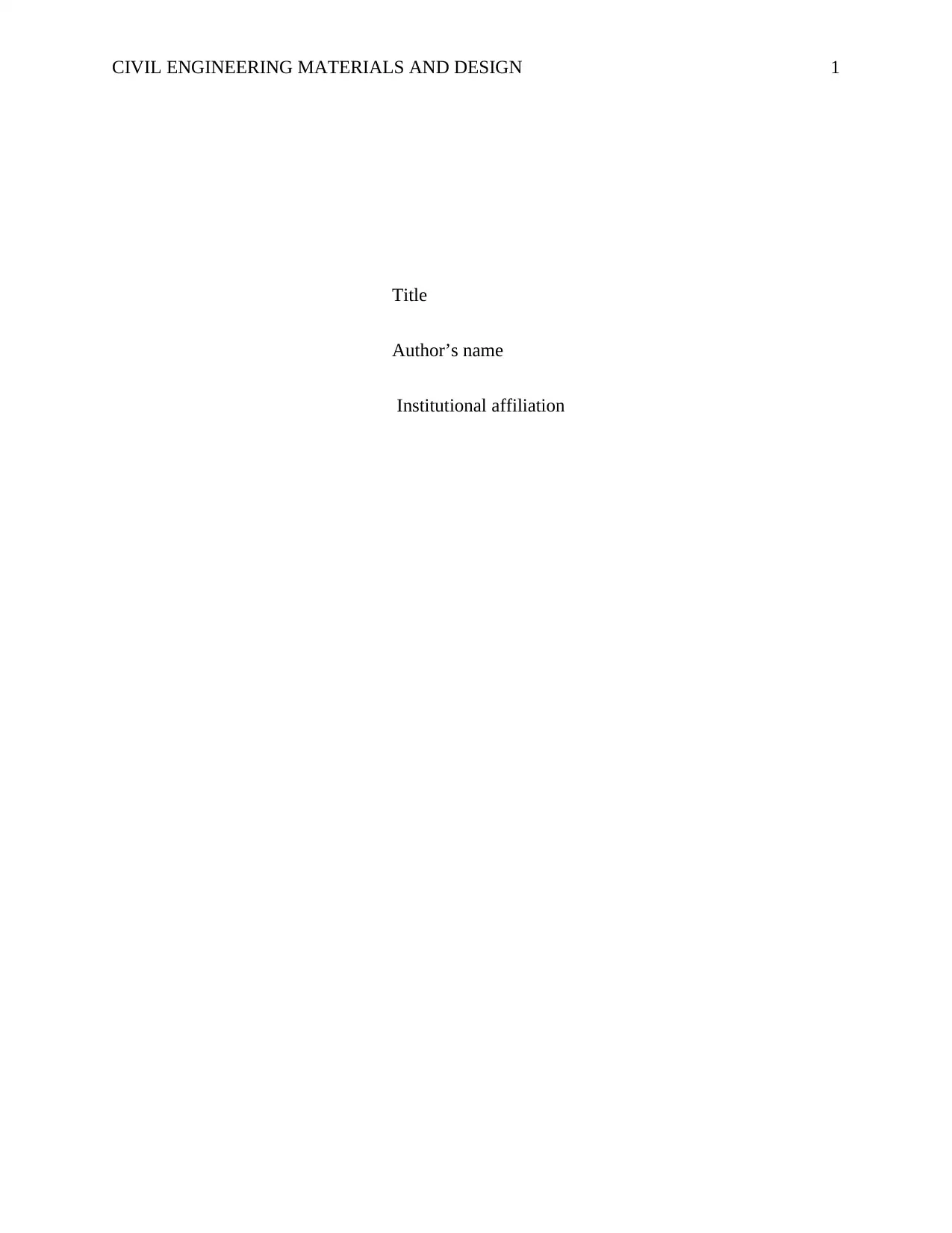
CIVIL ENGINEERING MATERIALS AND DESIGN 1
Title
Author’s name
Institutional affiliation
Title
Author’s name
Institutional affiliation
Paraphrase This Document
Need a fresh take? Get an instant paraphrase of this document with our AI Paraphraser
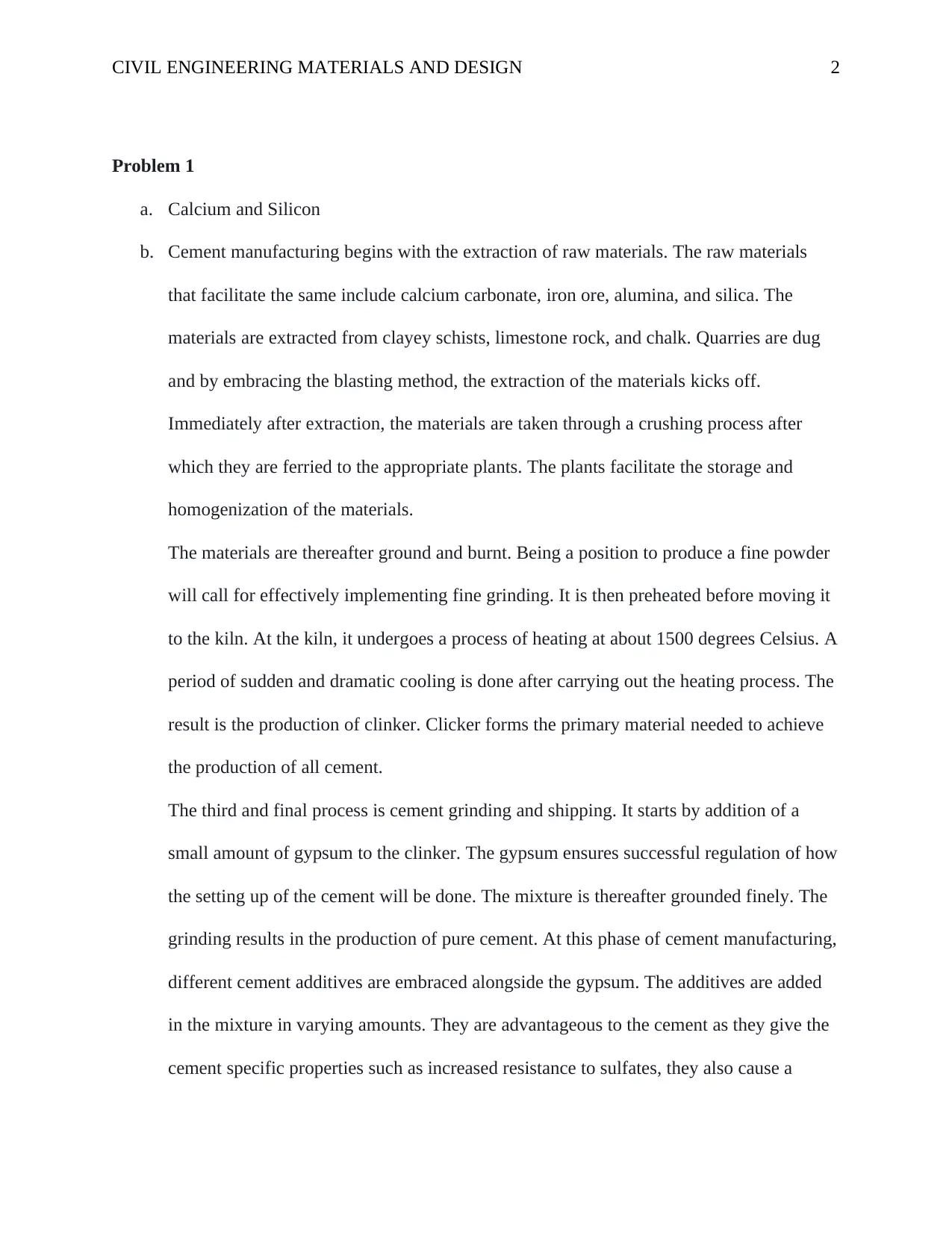
CIVIL ENGINEERING MATERIALS AND DESIGN 2
Problem 1
a. Calcium and Silicon
b. Cement manufacturing begins with the extraction of raw materials. The raw materials
that facilitate the same include calcium carbonate, iron ore, alumina, and silica. The
materials are extracted from clayey schists, limestone rock, and chalk. Quarries are dug
and by embracing the blasting method, the extraction of the materials kicks off.
Immediately after extraction, the materials are taken through a crushing process after
which they are ferried to the appropriate plants. The plants facilitate the storage and
homogenization of the materials.
The materials are thereafter ground and burnt. Being a position to produce a fine powder
will call for effectively implementing fine grinding. It is then preheated before moving it
to the kiln. At the kiln, it undergoes a process of heating at about 1500 degrees Celsius. A
period of sudden and dramatic cooling is done after carrying out the heating process. The
result is the production of clinker. Clicker forms the primary material needed to achieve
the production of all cement.
The third and final process is cement grinding and shipping. It starts by addition of a
small amount of gypsum to the clinker. The gypsum ensures successful regulation of how
the setting up of the cement will be done. The mixture is thereafter grounded finely. The
grinding results in the production of pure cement. At this phase of cement manufacturing,
different cement additives are embraced alongside the gypsum. The additives are added
in the mixture in varying amounts. They are advantageous to the cement as they give the
cement specific properties such as increased resistance to sulfates, they also cause a
Problem 1
a. Calcium and Silicon
b. Cement manufacturing begins with the extraction of raw materials. The raw materials
that facilitate the same include calcium carbonate, iron ore, alumina, and silica. The
materials are extracted from clayey schists, limestone rock, and chalk. Quarries are dug
and by embracing the blasting method, the extraction of the materials kicks off.
Immediately after extraction, the materials are taken through a crushing process after
which they are ferried to the appropriate plants. The plants facilitate the storage and
homogenization of the materials.
The materials are thereafter ground and burnt. Being a position to produce a fine powder
will call for effectively implementing fine grinding. It is then preheated before moving it
to the kiln. At the kiln, it undergoes a process of heating at about 1500 degrees Celsius. A
period of sudden and dramatic cooling is done after carrying out the heating process. The
result is the production of clinker. Clicker forms the primary material needed to achieve
the production of all cement.
The third and final process is cement grinding and shipping. It starts by addition of a
small amount of gypsum to the clinker. The gypsum ensures successful regulation of how
the setting up of the cement will be done. The mixture is thereafter grounded finely. The
grinding results in the production of pure cement. At this phase of cement manufacturing,
different cement additives are embraced alongside the gypsum. The additives are added
in the mixture in varying amounts. They are advantageous to the cement as they give the
cement specific properties such as increased resistance to sulfates, they also cause a

CIVIL ENGINEERING MATERIALS AND DESIGN 3
reduction in permeability, influencing an improvement on the workability of the cement,
raising the finishing quality of the cement and finally increasing its resistance to
aggressive environments. The cement is then stored in silos. The ferrying is done by
making use of bulks or bags and taken to the sites.
c. In cases where concrete is exposed to severe sulphate action, High Sulphate Resistant
Hydraulic Cement is used.
d. Workability of cement determines the water-cement ratio to be embraced. As one
embraces a greater amount of batch water to increase on the workability of concrete, the
addition of cement is also embraced as a way of ensuring that that the required water to
cement ratio is achieved.
e. One factor to be considered is compressive aggregate strength. Apart from that, there is
too the size gradation and texture, moisture content, bulk unit weight, and soundness.
Problem 2
a. Workability of concrete signifies concrete that can easily be placed. Desired workability
degrees vary for different types of concrete.
b. Fineness modules state the index levels of aggregate fineness and coarseness. The water
demand for the given concrete mix is affected by fineness modulus. As a result, the
workability, cohesion characteristics and compatibility are affected.
c. Cement materials have varying hardening and setting properties. The degree of which
some will harden and set will be much higher compared to others. High Early Strength
Portland Cement has a high content of alite. The alite is responsible for fastening the
hardening and setting process. The cement requires only 3 days to successfully display
the properties that will be exhibited by Portland cement in 7 days. They are beneficial in
reduction in permeability, influencing an improvement on the workability of the cement,
raising the finishing quality of the cement and finally increasing its resistance to
aggressive environments. The cement is then stored in silos. The ferrying is done by
making use of bulks or bags and taken to the sites.
c. In cases where concrete is exposed to severe sulphate action, High Sulphate Resistant
Hydraulic Cement is used.
d. Workability of cement determines the water-cement ratio to be embraced. As one
embraces a greater amount of batch water to increase on the workability of concrete, the
addition of cement is also embraced as a way of ensuring that that the required water to
cement ratio is achieved.
e. One factor to be considered is compressive aggregate strength. Apart from that, there is
too the size gradation and texture, moisture content, bulk unit weight, and soundness.
Problem 2
a. Workability of concrete signifies concrete that can easily be placed. Desired workability
degrees vary for different types of concrete.
b. Fineness modules state the index levels of aggregate fineness and coarseness. The water
demand for the given concrete mix is affected by fineness modulus. As a result, the
workability, cohesion characteristics and compatibility are affected.
c. Cement materials have varying hardening and setting properties. The degree of which
some will harden and set will be much higher compared to others. High Early Strength
Portland Cement has a high content of alite. The alite is responsible for fastening the
hardening and setting process. The cement requires only 3 days to successfully display
the properties that will be exhibited by Portland cement in 7 days. They are beneficial in
⊘ This is a preview!⊘
Do you want full access?
Subscribe today to unlock all pages.

Trusted by 1+ million students worldwide

CIVIL ENGINEERING MATERIALS AND DESIGN 4
places where urgent works are being done under cold weather conditions and there is a
need for sticking to the set schedules.
d. Gap grading of aggregate is primarily the aggregate particles forming voids that
experience penetration on condition that the next size of particles remains to be small. It
can be well represented on a graph with a horizontal line over the different size ranges.
e. A mechanism that involves a breakdown of chemicals in concrete is commonly referred
to as sulphate attack. The components of the cement experience an attack by sulphate
ions. The sulphates have capabilities of properly reacting with the different concrete
components. The two primary forms of sulphate attack include the chemical form of the
sulphate and the atmospheric environment surrounding the concrete.
Problem 4
Porosity is an associated trait with aggregates. As a result, they have a tendency of either
absorbing water into the body or the same can be retained. Different moisture states arise
from such from the trait.
In oven Dry State, there is the total removal of water through oven heating at a degree of
approximately 105 degrees Celsius. All the pores with the soil material are empty in such
a state. Air Dry state of water involves the removal of surface water; however, the
internal pores stay partially full.
Saturated Surface Dry state of water is a moisture content state where all pores of water
are filled with water but zero films on water noticed on the surface.
Wet state occurs when all pores are water-filled in addition to having a film on the
surface.
places where urgent works are being done under cold weather conditions and there is a
need for sticking to the set schedules.
d. Gap grading of aggregate is primarily the aggregate particles forming voids that
experience penetration on condition that the next size of particles remains to be small. It
can be well represented on a graph with a horizontal line over the different size ranges.
e. A mechanism that involves a breakdown of chemicals in concrete is commonly referred
to as sulphate attack. The components of the cement experience an attack by sulphate
ions. The sulphates have capabilities of properly reacting with the different concrete
components. The two primary forms of sulphate attack include the chemical form of the
sulphate and the atmospheric environment surrounding the concrete.
Problem 4
Porosity is an associated trait with aggregates. As a result, they have a tendency of either
absorbing water into the body or the same can be retained. Different moisture states arise
from such from the trait.
In oven Dry State, there is the total removal of water through oven heating at a degree of
approximately 105 degrees Celsius. All the pores with the soil material are empty in such
a state. Air Dry state of water involves the removal of surface water; however, the
internal pores stay partially full.
Saturated Surface Dry state of water is a moisture content state where all pores of water
are filled with water but zero films on water noticed on the surface.
Wet state occurs when all pores are water-filled in addition to having a film on the
surface.
Paraphrase This Document
Need a fresh take? Get an instant paraphrase of this document with our AI Paraphraser

CIVIL ENGINEERING MATERIALS AND DESIGN 5
Getting to know the moisture condition of aggregate before preparing a concrete mix is
highly significant. The compressive strength of concrete is dependent on the ratio of the
mass of water to the cement material. This is in line with Abrams Law. There is also a
need to understand that the ratio of water to cement has control over pore sizes and pore
volume in the concrete. As a result, the ratio does not only affect the strength but also the
durability of the concrete.
Natural Moisture Content is the quantity of water that is naturally found in aggregate.
Saturated Surface Dry Moisture Content is an aggregate condition where the particles
have a dry surface, the particle condition does not allow further adsorption however, the
voids within the particles are saturated with water.
Procedure for determining Natural Moisture Content of Fine Aggregate.
Clean the container, measure and record its weight
Crumble the wet soil and place it in the container, record its weight
Oven dry the soil sample for 24 hours
Remove the container from the oven
Record the new weight of the container and the soil sample
The occurred changes are determined the moisture content (Arvind Kumar Agnihotri,
2019).
Moisture content, W, is determined by (mass of moisture/mass of dry soil)*100%
Procedure for determining Saturated Surface Dry Moisture Content of Fine Aggregate
Soak the required quantity of fine aggregate in water for 24 hours
Take the soaked sand after 24 hours and spread it on an absorbent material such as cloth
material
Getting to know the moisture condition of aggregate before preparing a concrete mix is
highly significant. The compressive strength of concrete is dependent on the ratio of the
mass of water to the cement material. This is in line with Abrams Law. There is also a
need to understand that the ratio of water to cement has control over pore sizes and pore
volume in the concrete. As a result, the ratio does not only affect the strength but also the
durability of the concrete.
Natural Moisture Content is the quantity of water that is naturally found in aggregate.
Saturated Surface Dry Moisture Content is an aggregate condition where the particles
have a dry surface, the particle condition does not allow further adsorption however, the
voids within the particles are saturated with water.
Procedure for determining Natural Moisture Content of Fine Aggregate.
Clean the container, measure and record its weight
Crumble the wet soil and place it in the container, record its weight
Oven dry the soil sample for 24 hours
Remove the container from the oven
Record the new weight of the container and the soil sample
The occurred changes are determined the moisture content (Arvind Kumar Agnihotri,
2019).
Moisture content, W, is determined by (mass of moisture/mass of dry soil)*100%
Procedure for determining Saturated Surface Dry Moisture Content of Fine Aggregate
Soak the required quantity of fine aggregate in water for 24 hours
Take the soaked sand after 24 hours and spread it on an absorbent material such as cloth
material
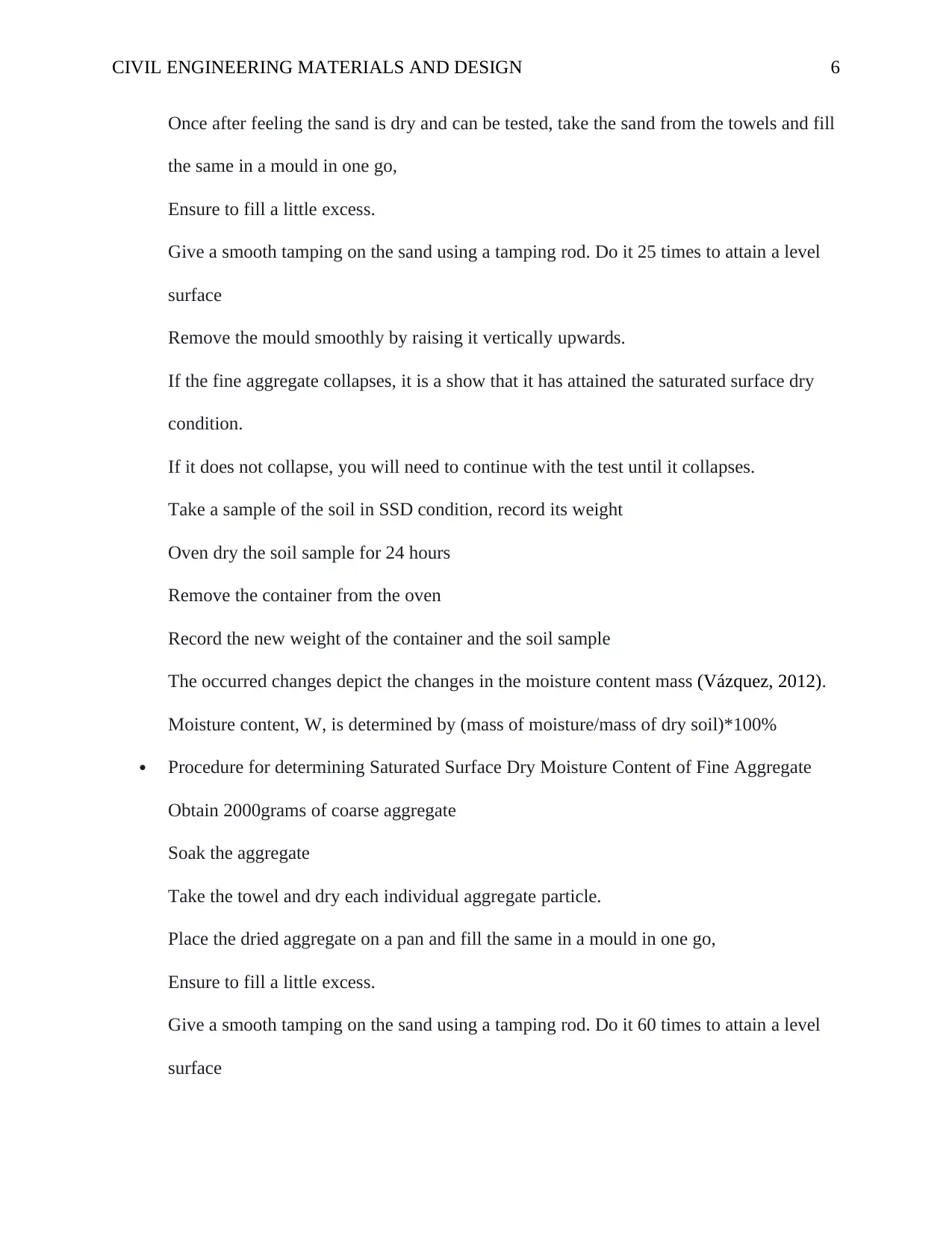
CIVIL ENGINEERING MATERIALS AND DESIGN 6
Once after feeling the sand is dry and can be tested, take the sand from the towels and fill
the same in a mould in one go,
Ensure to fill a little excess.
Give a smooth tamping on the sand using a tamping rod. Do it 25 times to attain a level
surface
Remove the mould smoothly by raising it vertically upwards.
If the fine aggregate collapses, it is a show that it has attained the saturated surface dry
condition.
If it does not collapse, you will need to continue with the test until it collapses.
Take a sample of the soil in SSD condition, record its weight
Oven dry the soil sample for 24 hours
Remove the container from the oven
Record the new weight of the container and the soil sample
The occurred changes depict the changes in the moisture content mass (Vázquez, 2012).
Moisture content, W, is determined by (mass of moisture/mass of dry soil)*100%
Procedure for determining Saturated Surface Dry Moisture Content of Fine Aggregate
Obtain 2000grams of coarse aggregate
Soak the aggregate
Take the towel and dry each individual aggregate particle.
Place the dried aggregate on a pan and fill the same in a mould in one go,
Ensure to fill a little excess.
Give a smooth tamping on the sand using a tamping rod. Do it 60 times to attain a level
surface
Once after feeling the sand is dry and can be tested, take the sand from the towels and fill
the same in a mould in one go,
Ensure to fill a little excess.
Give a smooth tamping on the sand using a tamping rod. Do it 25 times to attain a level
surface
Remove the mould smoothly by raising it vertically upwards.
If the fine aggregate collapses, it is a show that it has attained the saturated surface dry
condition.
If it does not collapse, you will need to continue with the test until it collapses.
Take a sample of the soil in SSD condition, record its weight
Oven dry the soil sample for 24 hours
Remove the container from the oven
Record the new weight of the container and the soil sample
The occurred changes depict the changes in the moisture content mass (Vázquez, 2012).
Moisture content, W, is determined by (mass of moisture/mass of dry soil)*100%
Procedure for determining Saturated Surface Dry Moisture Content of Fine Aggregate
Obtain 2000grams of coarse aggregate
Soak the aggregate
Take the towel and dry each individual aggregate particle.
Place the dried aggregate on a pan and fill the same in a mould in one go,
Ensure to fill a little excess.
Give a smooth tamping on the sand using a tamping rod. Do it 60 times to attain a level
surface
⊘ This is a preview!⊘
Do you want full access?
Subscribe today to unlock all pages.

Trusted by 1+ million students worldwide
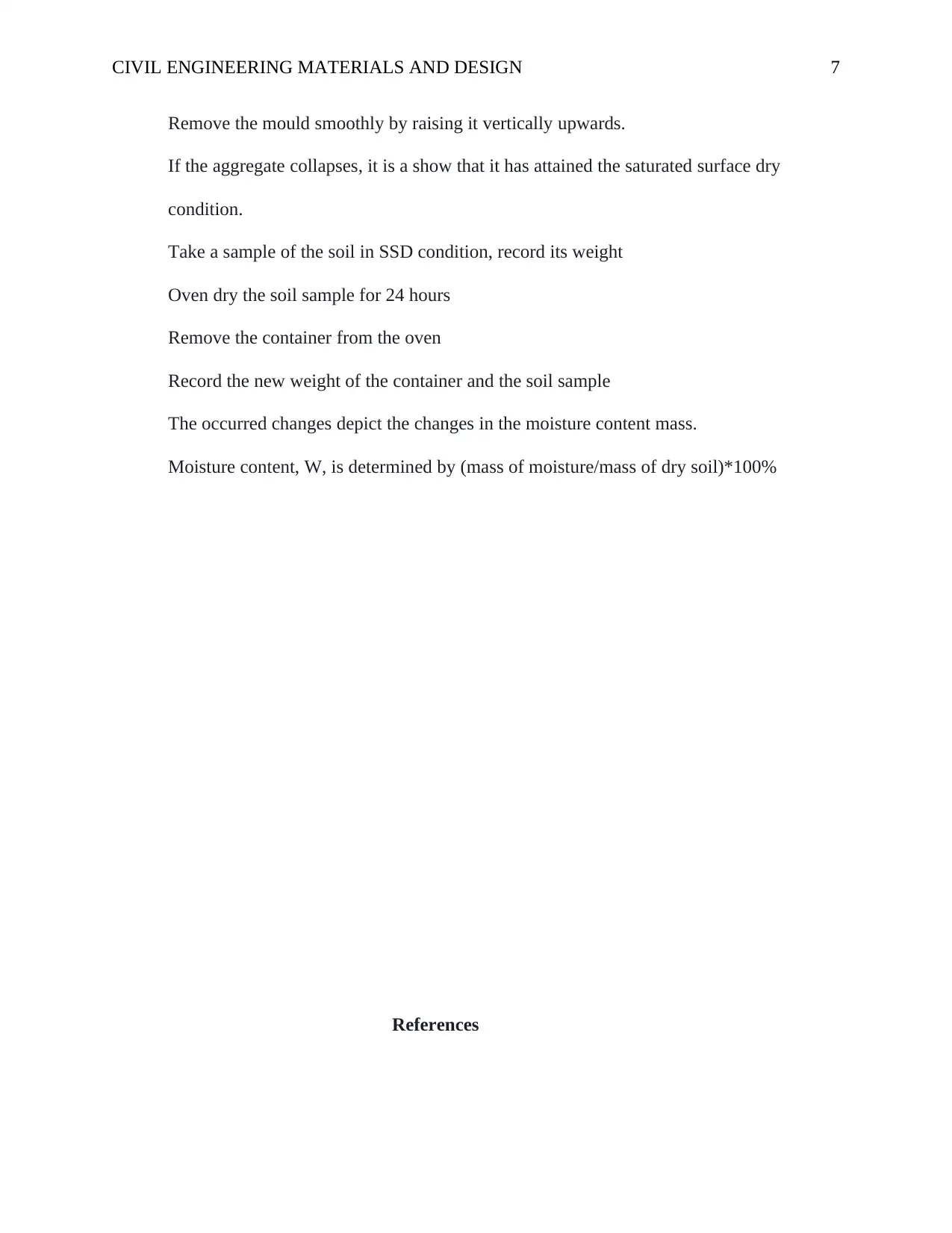
CIVIL ENGINEERING MATERIALS AND DESIGN 7
Remove the mould smoothly by raising it vertically upwards.
If the aggregate collapses, it is a show that it has attained the saturated surface dry
condition.
Take a sample of the soil in SSD condition, record its weight
Oven dry the soil sample for 24 hours
Remove the container from the oven
Record the new weight of the container and the soil sample
The occurred changes depict the changes in the moisture content mass.
Moisture content, W, is determined by (mass of moisture/mass of dry soil)*100%
References
Remove the mould smoothly by raising it vertically upwards.
If the aggregate collapses, it is a show that it has attained the saturated surface dry
condition.
Take a sample of the soil in SSD condition, record its weight
Oven dry the soil sample for 24 hours
Remove the container from the oven
Record the new weight of the container and the soil sample
The occurred changes depict the changes in the moisture content mass.
Moisture content, W, is determined by (mass of moisture/mass of dry soil)*100%
References
Paraphrase This Document
Need a fresh take? Get an instant paraphrase of this document with our AI Paraphraser
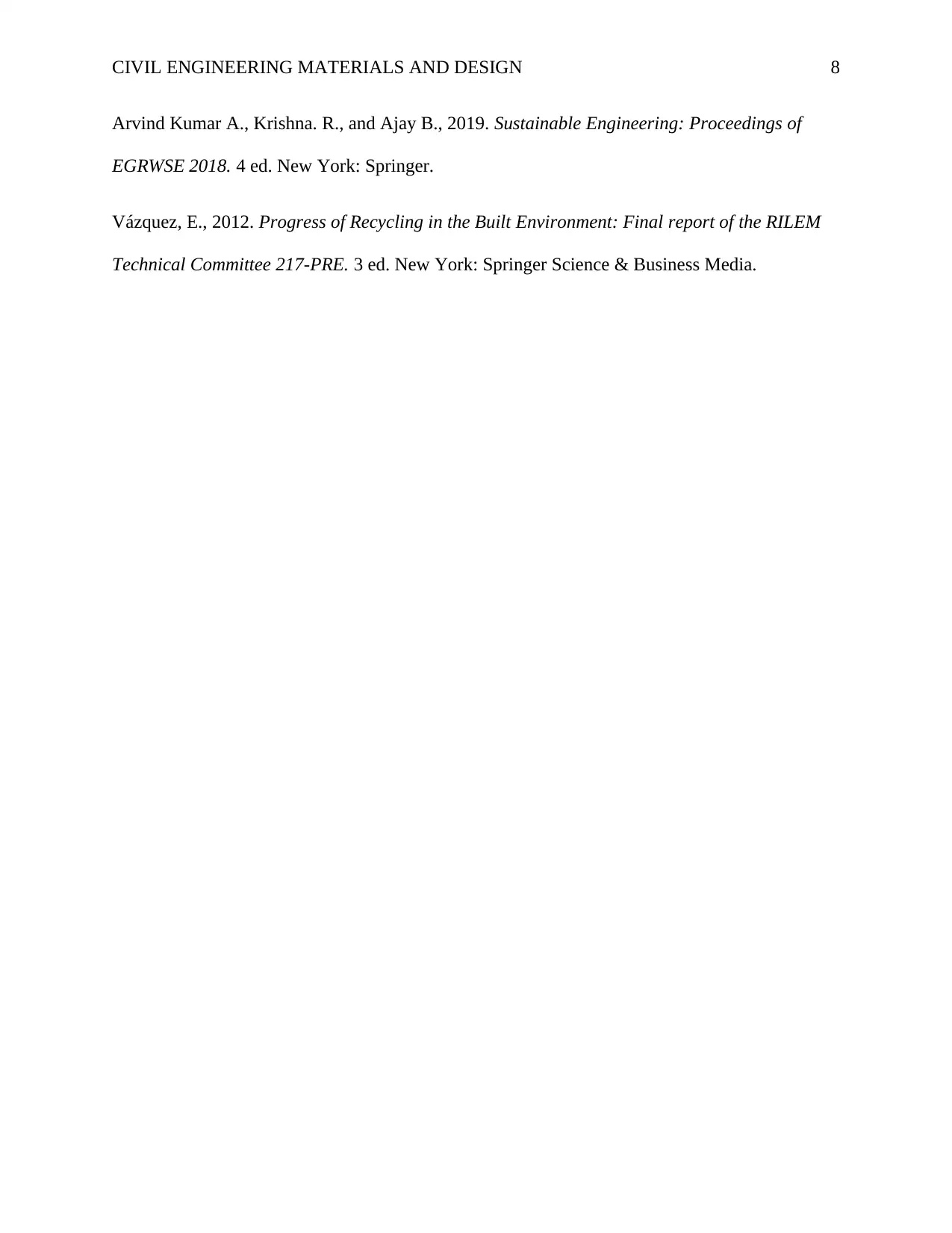
CIVIL ENGINEERING MATERIALS AND DESIGN 8
Arvind Kumar A., Krishna. R., and Ajay B., 2019. Sustainable Engineering: Proceedings of
EGRWSE 2018. 4 ed. New York: Springer.
Vázquez, E., 2012. Progress of Recycling in the Built Environment: Final report of the RILEM
Technical Committee 217-PRE. 3 ed. New York: Springer Science & Business Media.
Arvind Kumar A., Krishna. R., and Ajay B., 2019. Sustainable Engineering: Proceedings of
EGRWSE 2018. 4 ed. New York: Springer.
Vázquez, E., 2012. Progress of Recycling in the Built Environment: Final report of the RILEM
Technical Committee 217-PRE. 3 ed. New York: Springer Science & Business Media.
1 out of 8
Related Documents
Your All-in-One AI-Powered Toolkit for Academic Success.
+13062052269
info@desklib.com
Available 24*7 on WhatsApp / Email
![[object Object]](/_next/static/media/star-bottom.7253800d.svg)
Unlock your academic potential
Copyright © 2020–2025 A2Z Services. All Rights Reserved. Developed and managed by ZUCOL.





